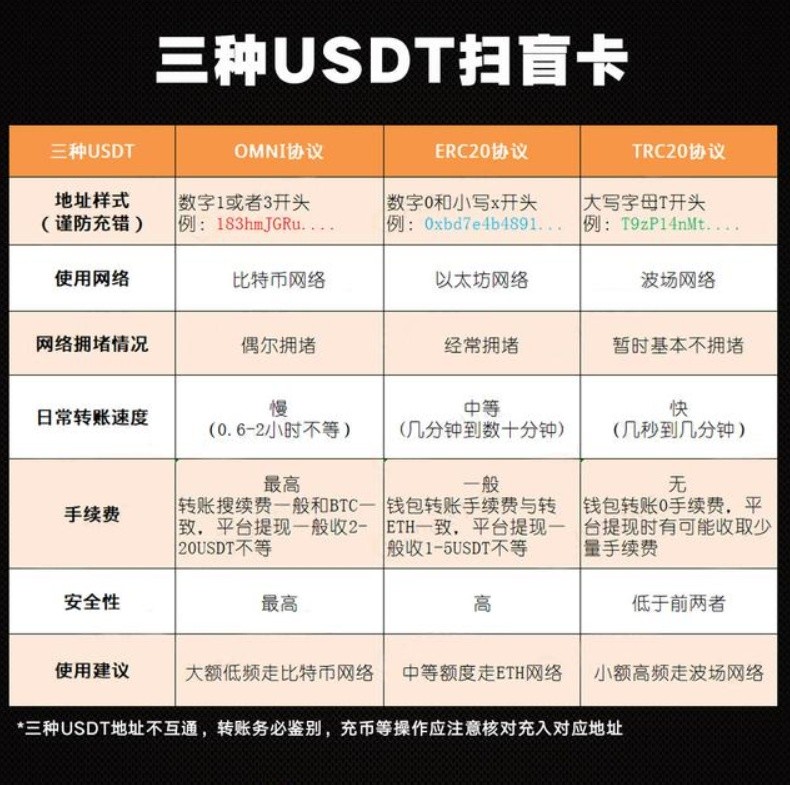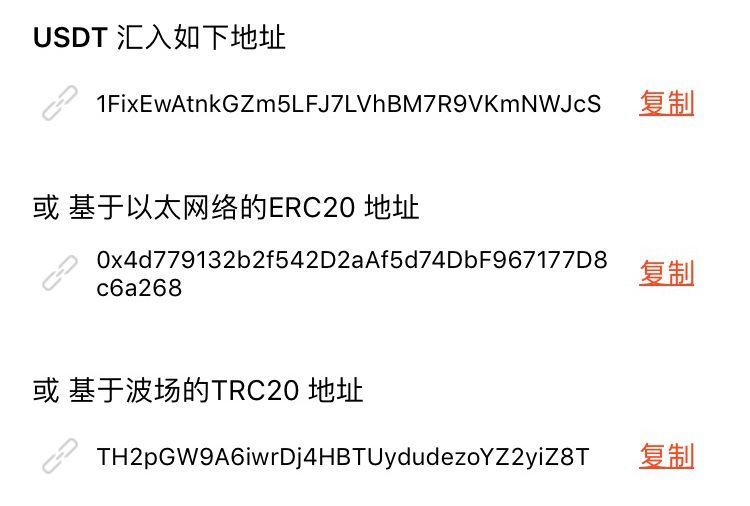USDT是当前实用最广泛,市值最高的稳定币,它是中心化的公司Tether发行的。在今年的4月17日之前,市场上存在着2种不同类型的USDT。4月17日又多了一种波场TRC20协议发行的USDT,它们各自有什么区别呢?哪个转账最快到账?哪种最安全?手续费最低?
USDT三种链类型Omni、ERC20、TRC20的区别
Tether公司发行发行的USDT稳定币一共有三种类型,分别是基于比特币、以太坊和TRON。基于比特币和基于以太坊的USDT,两者不兼容、不能相互转账,可以从存储的地址中判断USDT是属于哪一种。

USDT是Tether公司推出的基于稳定价值货币美元(USD)的代币Tether USD(简称USDT),1 USDT=1美元。
USDT的发行和交易使用的是Omni(原Mastercoin)协议,它是一个基于比特币区块链的2.0币种。USDT的交易确认等参数与比特币是一致的。用户可以通过SWIFT电汇美元至Tether公司提供的银行帐户,或通过交易所换取USDT。赎回美元时,反向操作即可。用户也可在交易所用比特币换取USDT。
Tether公司严格遵守1:1的准备金保证,即每发行1枚USDT代币,其银行帐户都会有1美元的资金保障。用户可以在Tether平台进行资金查询,以保障透明度。
USDT是中心化的公司Tether发行的。在今年的4月17日之前,市场上存在着2种不同类型的USDT。
第一种是基于比特币的USDT (基于Omni协议发行)。 这种USDT存储在比特币地址上,所以每次转账(链上转账)时,都需要支付少量的比特币作为矿工费。
除了转账需要比特币作为矿工费之外,每发起一笔USDT转账,都会对应地生成一笔数量极小的比特币转账。所以,每发起一笔基于比特币的USDT转账,钱包地址中至少要有0.0002个比特币才能保证转账成功。同时,收款方在收到一笔 USDT转账时,也会收到一笔最小金额的比特币转账。
第二种是基于以太坊的USDT(基于ERC-20协议发行)。这种USDT存储在以太坊地址上,相对应的,每次转账(链上转账)时,需要消耗Gas,也就是ETH。
目前,市场上的USDT绝大部分是基于比特币的USDT,基于以太坊的USDT份额很低(约3%)。
4月17日,第三种USDT诞生了,它是基于TRON网络(波场)发行的USDT。基于TRON网络的TRC-20 USDT,存储在TRON的地址当中,充值、提现都是通过TRON网络进行,而且转账免费。
上述三种USDT,哪种转账最快呢?因为波场网络达到1500TPS,目前来说转账最快。
哪种USDT转账最安全?有人表示波场的DPoS 27名超级节点没有其它两个网络来得安全,最安全的也就只有比特币网络了。
到底选哪个USDT好?
USDT is currently the most widely used stable currency with the highest market value. It is issued by the centralized company Tether. Before April 17 this year, there were two different types of USDT on the market. On April 17th, there was another USDT issued under the TRON TRC20 agreement. What is the difference between them? Which transfer is the fastest to arrive? Which is the safest? The lowest handling fee?
The difference between the three USDT chain types Omni, ERC20, and TRC20 There are three types of USDT stablecoins issued by Tether, which are based on Bitcoin, Ethereum and TRON. Based on Bitcoin and Ethereum-based USDT, the two are incompatible and cannot be transferred to each other. You can determine which kind of USDT belongs to from the sTored address.
USDT is the Tether USD (USDT) token based on the stable value currency U.S. dollar (USD) launched by Tether. 1 USDT=1 U.S. dollar.
USDT is issued and traded using the Omni (formerly Mastercoin) protocol, which is a 2.0 currency based on the Bitcoin blockchain. The USDT transaction confirmation and other parameters are consistent with Bitcoin. Users can wire US dollars through SWIFT to a bank account provided by Tether, or exchange USDT through an exchange. When redeeming USD, the reverse Operation is sufficient. Users can also exchange Bitcoin for USDT on the exchange.
Tether strictly abides by the 1:1 reserve guarantee, that is, for every USDT token issued, its bank account will have 1 USD fund guarantee. Users can conduct fund inquiries on the Tether platform to ensure transparency.
USDT is issued by the centralized company Tether. Before April 17 this year, there were two different types of USDT on the market.
The first type is Bitcoin-based USDT (issued based on the Omni protocol). This kind of USDT is stored on the Bitcoin address, so every time you transfer (transfer on the chain), you need to pay a small amount of Bitcoin as a miner's fee.
Except for the transfer of bitcoins as a miner fee, every time a USDT transfer is initiated, a very small bitcoin transfer will be generated accordingly. Therefore, every time a bitcoin-based USDT transfer is initiated, there must be at least 0.0002 bitcoins in the wallet address to ensure that the transfer is successful. At the same time, when the recipient receives a USDT transfer, it will also receive a minimum Bitcoin transfer.
The second type is USDT based on Ethereum (issued based on the ERC-20 protocol). This kind of USDT is stored on the Ethereum address. Correspondingly, every time you transfer (transfer on the chain), you need to consume Gas, which is ETH.
At present, most of the USDT in the market is based on Bitcoin, and the share of USDT based on Ethereum is very low (about 3%).
On April 17, the third type of USDT was born, which is based on the USDT issued by the TRON network (TRON). TRC-20 USDT, based on the TRON network, is stored in the TRON address. Deposits and withdrawals are made through the TRON network, and transfers are free.
Which of the above three USDT transfers is the fastest? Because the TRON network reaches 1500 TPS, it is currently the fastest to transfer money.
What kind of USDT transfer is the safest? Some people say that the 27 super nodes of TRON's DPoS are not as secure as the other two networks, and the most secure is only the Bitcoin network.
Which USDT to choose? Bitcoin-based USDT is recommended for large transfers, ERC-20 USDT based on Ethereum is a compromise, and TRON-based USDT can be selected for small transfers, which is faster.
02 Beware of asset loss when recharging and withdrawing. Bitcoin-based USDT and Ethereum-based USDT are incompatible and cannot be transferred to each other.
So, how do you know which kind of USDT your USDT belongs to?
In fact, it is very simple. You can judge from the stored USDT address: the address starts with "1" and belongs to the USDT based on Bitcoin; the address starts with "0x" and belongs to the USDT based on Ethereum. In other words, Bitcoin-based USDT can only be stored on Bitcoin addresses; Ethereum-based USDT can only be stored on Ethereum addresses.
As for the third type of USDT based on TRON, some trading platforms currently support it, and the address starts with "T".
▲ Three examples of USDT addresses Whether it is transfer, or recharge or withdrawal from the trading platform, you need to pay attention to distinguish the type of USDT to be operated. USDT is issued by the centralized company Tether. Before April 17 this year, there were two different types of USDT on the market.
The first OMNI protocol address style: beginning with the number 1 or 3 Example: 183hmJGRu...
Using the network: Bitcoin network network congestion: occasional congestion Daily transfer speed: slow (ranging from 0.6-2 hours)
Handling fee: the highest, the transfer search and renewal fee is generally the same as BTC, and the platform withdrawal generally charges 2-20USDT. "Security: the highest use suggestion: large low-frequency use of the Bitcoin network. The second ERC20 protocol address style: number 0 and lowercase x Starting example: 0xbd7e4b4891...Used network: Ethereum network network congestion situation: frequent congestion Daily transfer speed: medium (a few minutes to tens of minutes)
Handling fee: In general, the wallet transfer fee is the same as that of ETH, and the platform withdrawal generally accepts 1-5 USDT. Security: High usage suggestion: medium amount to take the ETH network. The third TRC20 protocol address style: (beware of wrong filling) capital letters Example at the beginning of T: T9zP14nMt...
Using the network: TRON network network congestion: temporarily not congested, daily transfer speed: fast (a few seconds to a few minutes)
Handling fee: none, zero handling fee for wallet transfer, and a small handling fee may be charged when the platform withdraws. "Security: lower than the first two. Suggestions for use: small high-frequency TRON network, which is the fastest transfer?
Because the TPS network of TRON has reached 1500TPS, currently, the fastest transfer to the account is TRON USDT.
What kind of USDT transfer is the safest?
Someone said that TRON’s 27 DPOS super nodes are not as safe as the other two networks. The only safest thing is the Bitcoin network.
Which USDT is better and the lowest handling fee?
In summary, the absolute security and speed of the blockchain can’t have both at the moment. 1. For large transfers, we recommend the USDT of the Bitcoin network Omini. The handling fee is more expensive and slower, but the safest 2. For medium-sized transfers, choose ERC20 USDT. The handling fee is average, the speed is average, and the security is high. 3. TRON USDT can be used for small transfers, which is faster. TRON network transfer itself does not charge a handling fee (the trading platform may charge some).
For specific comparisons, please see the list below: (Long press to save favorites)
The remedy when the platform recharges USDT to the wrong BTC, ETH, TRX recharge address: You can only find the corresponding platform customer service, and some platforms can be retrieved.
There is also a charging error situation. If you charge to the ETH or TRX address of a trading platform that does not support ERC20TRC20 USDT, you may need to wait for the platform to launch the corresponding type of agreement USDT before you can withdraw it.
大笔转账推荐基于比特币的USDT,折中选择基于以太坊的ERC-20 USDT,小额转账可以选择基于波场的USDT,速度更快一点。
02 充值、提现时谨防资产丢失
基于比特币的USDT,和基于以太坊的USDT,两者是不兼容、不能相互转账的。
那么,如何知道你的USDT,是属于哪一种USDT呢?
其实很简单,可以通过存储的USDT地址判断:地址是“1”开头的,属于基于比特币的USDT;地址是“0x”开头的,属于基于以太坊的USDT。换句话说,基于比特币的USDT,只能存储在比特币地址上;基于以太坊的USDT,只能存储在以太坊地址上。
至于第三种基于TRON的USDT,目前有一部分交易平台已经支持了,地址是“T”开头的。

▲ 三种USDT地址示例
无论是转账,还是从交易平台充值、提现,都需要注意分清楚将要操作的USDT是属于哪一种类型
- 内容分页 1 2
